Hello there!
I've been a passive reader in the forums for a while, and have been anyways interested in building things and diy. I recently wanted to build a Bluetooth speaker system on my own for as cheap as possible, but pretty good quality.
I am totally a beginner in any diy audio systems. I went ahead and imported the Dayton Audio TCP115-4 which was nowhere available in India directly for any reasonable price.
Now note that my whole build process is a trial and error and not really structured in any way. I mostly work on the weekends and whenever i get free time on this.
Now started my search for an amp.
I initially wanted some sort of DSP to process the signal and pass it over to a mono amp. But I couldn't find any good DSP for a reasonable (cheap) price. There was ADAU1401 which I heard about, but need to be imported from China and no seller seem to ship them to India at present.
But then I found Wuzhi Audio ZK502-M for a relatively cheap price. I don't have any DSP control or anything, but it is a 2x50W amp with built in birth, 3.5mm jack and USB. For the time being, it should serve my use.
My plan was to power it from a 3s Lithium ion battery pack, so I had bought 3x18650 cells, BMS and a battery holder (I don't have a spot welder). But it's only now that i noticed, though the amp says it has an input voltage range of 5v-24v, the output power totally depends on how much you feed it. So I needed something close to 20V.
Now with that in mind, my plan was to make a 5s battery pack, but I wanted to be able to charge it with USB C. Sadly, the best I could find was 4s charging board. So ordered 4s charger, extra batteries and 4s bms, plus a DC-DC boost converter (along with some fuse, charge indicator led, switch, etc), and a 4700uF capacitor to the input power of the amp.
Now that i have the electronics sorted out, I tried this setup out in a 10L water can. The sound was good, but a bit muffled. My original plan was to go with no tweeter for the time being and add it later on, but I now understood that won't be a good idea.
So off to buy a good tweeter and building a crossover.
Got myself Dayton Audio ND16FA-4, and couple of components for the passive crossover (will post the xsim simulation and other details in a separate post), and built everything.
The sound felt pretty good
Now came the biggest hurdle: The enclosure. I don't have any wood working tools, so working with MDF or wood would have been tough. I thought of another idea (inspired from the design of other bluetooth speakers). To use a 5 inch pipe, placing the speaker on one end. I couldn't get any 5 inch pipe nearby, so I bought a 6 inch one and a 6 inch to 4 inch reducer. Drilled some mounting holes on it, covered the surface where the tcp115 will meet it with some foam tape and mounted it. But now came the tweeter. Where do i attach it? I didn't want to drill a hole in the pipe.
I didn't have much time at this point, so the tweeter laid outside on the ground for a few days while i was testing it this way. I also found it was difficult to get a grill for the speakers, and a lot of things required really custom stuff.
Now this is not cheap or economical, but I've always wanted a 3d printer. Felt this is the right time, and got myself one.
I printed one custom mount to mount the tweeter just over to the side of the woofer, and the grill.
Wrapped the pipe with some fabric vinyl and now it, lined the sides of the inside of the pipe with some acoustic foam and filled with polyfill. For the crossover, currently I just twisted all the connections and covered each component with foam tape, and then one round of foam over all. Then pushed it inside the pipe. The polyfill just keeps it there in place.
Now what's left for me is to put the batteries, amp and other electronic components inside the enclosure and close up the other side.
Posting some images🙂
Please do share your review/suggestions
I've been a passive reader in the forums for a while, and have been anyways interested in building things and diy. I recently wanted to build a Bluetooth speaker system on my own for as cheap as possible, but pretty good quality.
I am totally a beginner in any diy audio systems. I went ahead and imported the Dayton Audio TCP115-4 which was nowhere available in India directly for any reasonable price.
Now note that my whole build process is a trial and error and not really structured in any way. I mostly work on the weekends and whenever i get free time on this.
Now started my search for an amp.
I initially wanted some sort of DSP to process the signal and pass it over to a mono amp. But I couldn't find any good DSP for a reasonable (cheap) price. There was ADAU1401 which I heard about, but need to be imported from China and no seller seem to ship them to India at present.
But then I found Wuzhi Audio ZK502-M for a relatively cheap price. I don't have any DSP control or anything, but it is a 2x50W amp with built in birth, 3.5mm jack and USB. For the time being, it should serve my use.
My plan was to power it from a 3s Lithium ion battery pack, so I had bought 3x18650 cells, BMS and a battery holder (I don't have a spot welder). But it's only now that i noticed, though the amp says it has an input voltage range of 5v-24v, the output power totally depends on how much you feed it. So I needed something close to 20V.
Now with that in mind, my plan was to make a 5s battery pack, but I wanted to be able to charge it with USB C. Sadly, the best I could find was 4s charging board. So ordered 4s charger, extra batteries and 4s bms, plus a DC-DC boost converter (along with some fuse, charge indicator led, switch, etc), and a 4700uF capacitor to the input power of the amp.
Now that i have the electronics sorted out, I tried this setup out in a 10L water can. The sound was good, but a bit muffled. My original plan was to go with no tweeter for the time being and add it later on, but I now understood that won't be a good idea.
So off to buy a good tweeter and building a crossover.
Got myself Dayton Audio ND16FA-4, and couple of components for the passive crossover (will post the xsim simulation and other details in a separate post), and built everything.
The sound felt pretty good
Now came the biggest hurdle: The enclosure. I don't have any wood working tools, so working with MDF or wood would have been tough. I thought of another idea (inspired from the design of other bluetooth speakers). To use a 5 inch pipe, placing the speaker on one end. I couldn't get any 5 inch pipe nearby, so I bought a 6 inch one and a 6 inch to 4 inch reducer. Drilled some mounting holes on it, covered the surface where the tcp115 will meet it with some foam tape and mounted it. But now came the tweeter. Where do i attach it? I didn't want to drill a hole in the pipe.
I didn't have much time at this point, so the tweeter laid outside on the ground for a few days while i was testing it this way. I also found it was difficult to get a grill for the speakers, and a lot of things required really custom stuff.
Now this is not cheap or economical, but I've always wanted a 3d printer. Felt this is the right time, and got myself one.
I printed one custom mount to mount the tweeter just over to the side of the woofer, and the grill.
Wrapped the pipe with some fabric vinyl and now it, lined the sides of the inside of the pipe with some acoustic foam and filled with polyfill. For the crossover, currently I just twisted all the connections and covered each component with foam tape, and then one round of foam over all. Then pushed it inside the pipe. The polyfill just keeps it there in place.
Now what's left for me is to put the batteries, amp and other electronic components inside the enclosure and close up the other side.
Posting some images🙂
Please do share your review/suggestions
Attachments
-
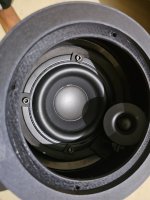 20250209_134401.jpg357.2 KB · Views: 83
20250209_134401.jpg357.2 KB · Views: 83 -
 20250209_134413.jpg486.1 KB · Views: 48
20250209_134413.jpg486.1 KB · Views: 48 -
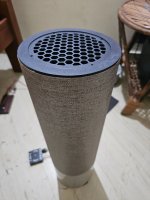 20250209_130353.jpg437.3 KB · Views: 48
20250209_130353.jpg437.3 KB · Views: 48 -
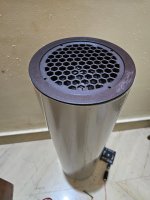 20250208_072948.jpg410.2 KB · Views: 47
20250208_072948.jpg410.2 KB · Views: 47 -
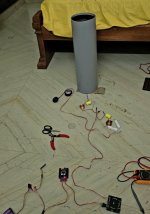 Screenshot_20250209_232655_Gallery.jpg204.2 KB · Views: 42
Screenshot_20250209_232655_Gallery.jpg204.2 KB · Views: 42 -
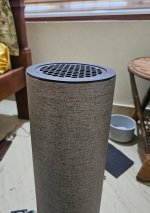 Screenshot_20250209_232547_Gallery.jpg221.8 KB · Views: 44
Screenshot_20250209_232547_Gallery.jpg221.8 KB · Views: 44 -
 Screenshot_20250209_232455_Photos.jpg178.5 KB · Views: 50
Screenshot_20250209_232455_Photos.jpg178.5 KB · Views: 50 -
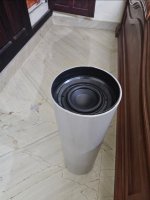 Screenshot_20250209_232426_Photos.jpg216.3 KB · Views: 49
Screenshot_20250209_232426_Photos.jpg216.3 KB · Views: 49
Yes, the pipe is a standard plumbing PVC pipe (about 50cm long). It's got 3mm thick walls, which are pretty sturdy, but still I lined the inside walls with high density foam to dampen any vibrations.
Thanks! The fabric was one of the easiest parts though, costed about $2, but adds a lot of personality.
I haven't had an opportunity (or the equipment) to do a comprehensive test, but I had compared it side to side with a JBL charge 5, and it sounded way better and fuller. Not really a good comparison, but yeah. The bass was also much powerful. But the JBL was way too portable than carrying a half meter pipe😂.
I haven't had an opportunity (or the equipment) to do a comprehensive test, but I had compared it side to side with a JBL charge 5, and it sounded way better and fuller. Not really a good comparison, but yeah. The bass was also much powerful. But the JBL was way too portable than carrying a half meter pipe😂.
Could always try to find 18mm MDF or Pine Shelf boards as well for easy cheap wood.
Little bracing goes a long way. To make a more standard type enclosure that is cost effective.
Around here it is practically free from apartment and home construction drop.
Construction dumpsters are full of brand new pieces of various lengths.
Many glass manufactures will have huge shipping crates made of pine sitting in back as well.
Some will even use high ply count plywood for shipping crates.
Little bracing goes a long way. To make a more standard type enclosure that is cost effective.
Around here it is practically free from apartment and home construction drop.
Construction dumpsters are full of brand new pieces of various lengths.
Many glass manufactures will have huge shipping crates made of pine sitting in back as well.
Some will even use high ply count plywood for shipping crates.
Thanks for the suggestion! I do have easy access to MDF and wood, but I don’t have woodworking tools or experience yet (though I want to try it out some time). That’s why I went with PVC for this build. Definitely something to consider for future projects, though!
I had bought 2x tcp115 drivers, so maybe I'll try to work with MDF for it's enclosure🙂.
I had bought 2x tcp115 drivers, so maybe I'll try to work with MDF for it's enclosure🙂.
Can get pretty far with a square, clamps and level for a saw guide. Just a basic circular saw. Since high tooth count blades are cheap in 7 1/4 inch.
60 tooth with carbide was really expensive in maybe the 80's lol. Wont be more than 15 to 20 bucks in the modern world.
Dont set the blade deep, just barely clear the wood. Cut like butter. Cutting deep is basically pounding the surface. Just barely clear the under surface
60 tooth with carbide was really expensive in maybe the 80's lol. Wont be more than 15 to 20 bucks in the modern world.
Dont set the blade deep, just barely clear the wood. Cut like butter. Cutting deep is basically pounding the surface. Just barely clear the under surface
Last edited:
Thanks for the suggestion! I had no idea what I was doing and almost bought a jigsaw before deciding on PVC. Seems like a circular saw is the way to go—I'll definitely keep that in mind for my next build. Hopefully, it'll be a wooden enclosure since I have some wood from old doors lying around.
I just checked, and I can get a circular saw and blade for under $60 here, so that’s great!
One question, though—what’s the best way to get clean, precise cuts for speaker holes and joints? Would a hole saw bit on a drill work for the speaker cutout, or is there a better method? And for straight cuts, is a simple saw guide enough, or should I consider anything else?
I’m completely new to woodworking (aside from a few YouTube videos), so any beginner-friendly tips would be super helpful!
I just checked, and I can get a circular saw and blade for under $60 here, so that’s great!
One question, though—what’s the best way to get clean, precise cuts for speaker holes and joints? Would a hole saw bit on a drill work for the speaker cutout, or is there a better method? And for straight cuts, is a simple saw guide enough, or should I consider anything else?
I’m completely new to woodworking (aside from a few YouTube videos), so any beginner-friendly tips would be super helpful!
- Home
- Member Areas
- Introductions
- My first speaker build: Dayton TCP115-4 with ND16FA-4 in a pipe!